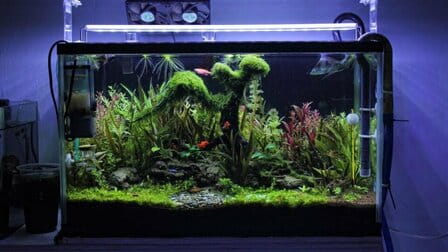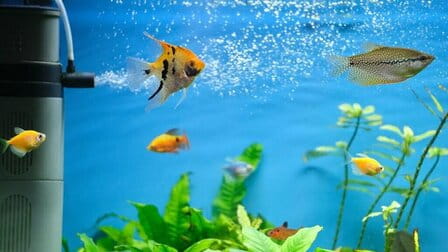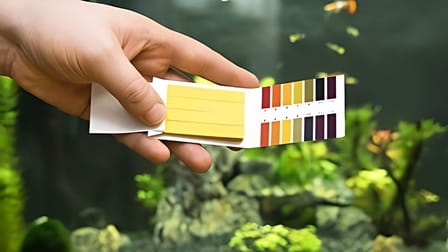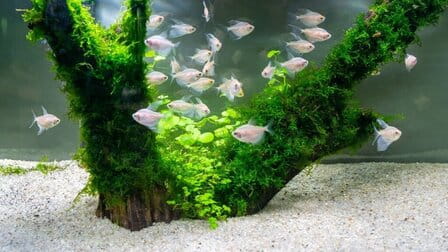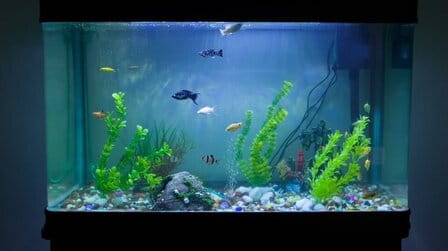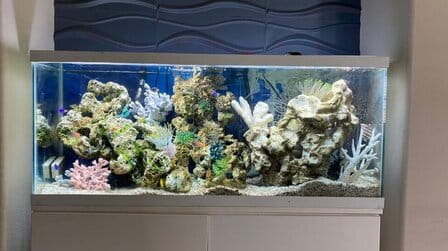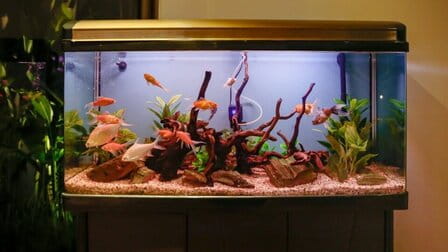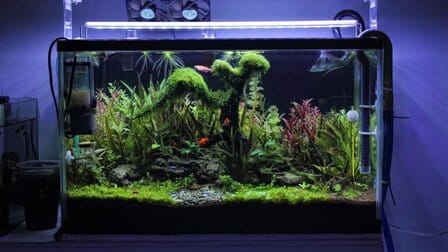If you are in the habit of testing your water and know the pH is high, it means it is too basic or too alkaline. Water with a high pH can have some serious consequences, whether drinking it or using it in a pool, aquarium, or garden. In an aquarium, a high pH can make your fish very sick. Or in the pool, the high pH can irritate the skin and eyes. However, there are many ways to lower the pH in water, let's learn how to lower pH safely.
1. Drink water
1.1 Add lemon juice to a glass of water to adjust the portion
If you don't want to treat the water at the source and don't mind the sour taste in the water, add 2-3 drops of lemon juice to an 8 fl oz (240 mL) cup of water. Lemon lowers the pH of water naturally by making it more acidic.
Or you can also try dropping a lemon into the water if you want a stronger lemon flavor.
Using pure citric acid will also have the same effect.
1.2 Install a water filter on your faucet to lower the pH at the source
Water filters work by removing minerals that can raise the pH of water, including sodium, fluoride, and potassium. Depending on the model you choose, the filter can usually be screwed onto the faucet. When you turn on the faucet, the filter lowers the pH of the water. Furthermore, you can find water filters at any home improvement store or supermarket.
Most home water filters can filter about 10 US gal (38 L) of water per hour.
1.3 Lowering pH with a food-grade acid
Some food-grade preparations of phosphoric, sulfuric, and lactic acids are used when a recipe, like fermentation, requires a lower pH. The ratio of these acids in the water will depend on the type of acid chosen and the pH trying to achieve, so read the packaging carefully before using.
These products are often sold in places that supply food, fermentation, and brewing. Even if acids are added to the water, they will leave behind harmless compounds after they are neutralized. Just make sure to read the label and use it correctly.
1.4 Installing the acid spray system
Acid spray systems balance water by sensing the pH level where it leaves the source. The system then injects food-grade acid into the water's flow to balance it out of the faucet. Installation of this type of system should involve a treatment professional, so speak to a local water supply professional in your area if you are concerned.
System and installation can easily go up to $1500, but if you're having problems with high pH in your water, it's an effective solution.
2. Garden grounds
2.1 Research on pH needs in the water of plants
Before lowering the pH of the water, make sure the plants prefer an acidic environment. Some plants, like azaleas and sweet potatoes, prefer acidity. However, other plants, including wisteria and sugar beets, prefer neutral or slightly alkaline environments.
Most plants thrive in the pH range of 5.5-7.0.
2.2 Pour lemon juice into the watering can to remedy the natural situation
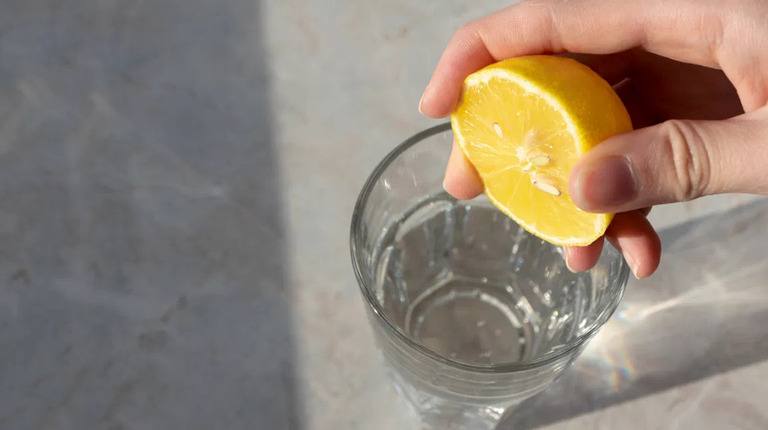
If you add 1⁄8 teaspoon (0.62 mL) of lemon juice to 1 gal (3,800 mL) of water, the pH can be reduced by about 1.5 points. Lemon juice can be squeezed fresh or bottled, but make sure it's 100% pure.
Alternatively, citric acid can be used instead, but it may need to be dissolved in a little water first.
If you plan to test the water again, stir in the lemon juice and wait for about 5 minutes to make sure it is evenly distributed throughout the water.
2.3 Add vinegar to water
You need to measure out 1 US tablespoon (15 mL) of regular white vinegar and pour it into 1 US gal (3,800 mL) of water. The natural acidity of the vinegar will help neutralize the alkalinity in the water, bringing the pH from 7.5-7.7 down to about 5.8-6.0.
Vinegar has a pH of 2-3 and lemon juice has a pH of 2, so their effects on the water are similar.
3. Swimming pool
3.1 Add muriatic acid

Muriatic acid, or hydrochloric acid, is used in swimming pools to lower the pH. Depending on the preparation you choose, the acid can be added directly to the pool or diluted in a bucket of water, then poured into the pool. When pouring muriatic acid in, keep the container close to the surface of the water so it doesn't splash back on you. Also, pour the acid directly onto the return faucet so it circulates through the water quickly, and make sure that the vent on the pool faucet is facing down, if applicable.
On the other hand, muriatic acid can be purchased anywhere that sells pool supplies. Read the label carefully to determine how much muriatic acid to add to the pool.
Add less than you want, wait 4 hours, and check again. Add more if necessary. Note that muriatic acid and sodium bisulfate are both corrosive chemicals. Work in a ventilated area, wearing gloves and eye protection. After you add muriatic acid, wait at least 4 hours before allowing anyone in the pool.
3.2 Sodium bisulfate
Sodium bisulfate is usually in the form of granules, and depending on the manufacturer's instructions, can be added directly to the water, or dissolved in a bucket and then poured into the pool. Sodium bisulfate helps stabilize the pH in the pool after it is lowered, so it may be a better choice for long-term maintenance. Although it is a dangerous chemical, sodium bisulfate is not as harsh as muriatic acid. However, it may not work as quickly and often reduces the total alkalinity (TA) in the pool more than might be desired.
Use the packaging and your pH measurement to determine how much sodium bisulfate to add to the pool. Also, Sodium bisulfate is found wherever you buy pool supplies.
3.3 Installation of CO2. system
Some CO2 systems are fully automated, meaning the system will monitor the pH level in the pool and will add CO2 to lower the pH as needed. Some are manually controlled, so it will be necessary to check levels daily and adjust CO2 flow as needed. Furthermore, to determine which one is right for you, talk to a pool professional in the area.
Overall, these systems range from $300 to over $10,000, depending on the features, but can save you money if you're spending a lot on chemicals to balance pH.
3.4 Test the pH at least twice a week with the test kit
The chemicals used in the pool will become unbalanced if they are left unattended, so the pH in the pool should be checked about 2-3 times a week, even if it is balanced. You can use a litmus test strip if you like, but a set of DPD test strips will give accurate results. These kits measure the pH and total alkalinity (TA) of the water, along with the pool's chlorine concentration, making it easier to balance the pool.
Oils from the skin, sunscreen or certain cosmetics, lotions, and dirt can all alter the pH balance in the pool. If the pool is being used daily, you may need to check it daily.
4. Aquarium
4.1 Install a CO2 bubbler to temporarily lower the pH in the aquarium
Adding a CO2 bubbler to the tank can lower the pH slightly and works quickly, so is a good choice if the pH rises suddenly. However, CO2 is very expensive and pH will rise again after CO2 is gone, so this is not a good solution in the long run.
Alternatively, you can find CO2 for your tank at a tank supply store. However, adjusting the pH of the aquarium too quickly can shock the fish. To avoid this, remove the fish from the aquarium before attempting to lower the pH.
4.2 Try a reverse osmosis filter for a large aquarium
The reverse osmosis filter is an extremely efficient filter that removes up to 99% of contaminants from the water while retaining the ions that keep fish healthy. Since contaminants raise the pH of the water, the filter will naturally lower the pH level as it cleans the water.
These filters can cost up to $50 and take up a lot of space, so are best for larger tanks.
4.3 Put driftwood in the aquarium for natural filtration and decoration

In addition to the beauty in the aquarium, driftwood also naturally filters the water in the tank. Even small pieces of natural driftwood will lower the pH in the tank and help stabilize it. In addition, the wood will give the fish a new place to explore.
Sometimes driftwood can discolor the water in the tank. To avoid this, soak the wood in a bucket of water for a few days before putting it in the tank.
Do not use reptile tank driftwood in an aquarium. As it may have been soaked in chemicals that could leak into the water and harm the fish's habitat.
4.4 Add peat moss to the filter

Since this can clump together and remove during tank cleaning, it is best to place it inside a mesh bag, then place the bag and inside the filter. Peat moss will naturally aid the filter, helping to lower the pH in the tank. Use the size of the filter to help determine how much moss to use.
Peat moss also easily discolors the water in the tank. To avoid this, soak it for a few days in a bucket of water before placing it in the tank.
The amount of peat moss you should use will depend on the size of your tank and the pH level you are trying to achieve. Experiment with different amounts to find which is right for the tank.
4.5 Drop 2-3 Catappa leaves into the tank

The leaves of the Catappa tree, or Indian almond tree, contain several chemicals that help filter contaminants from your water. Not only does it help lower the pH of the water to a more stable level, but these chemicals can prevent or cure some fish diseases, so the leaves can help keep fish healthy.
The tannins in the Catappa leaves can slightly change the color of the water.
4.6 Remove crushed coral
If you're having problems with a high pH level in your tank, that could be the cause of the substrate. While it looks great in the tank, crushed coral can raise the pH of the water, so it should only be used if your fish prefer a more alkaline environment.
Conclusion
Each method has its own pros and cons. How to lower pH safely that you need to consider when applying it to your water source. If you're setting up a tank for the first time, it's more flexible and safer to do things the right way.
But if you make adjustments to fish and plants already in the ecosystem. You need to carefully follow any instructions that come with the chosen chemical or additive and regularly test the water to make sure parameters are not missed.

